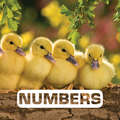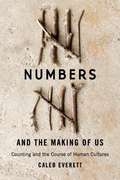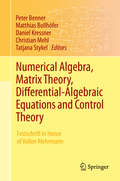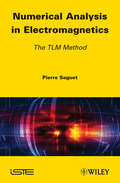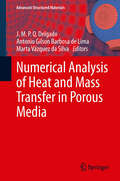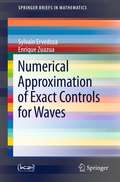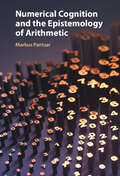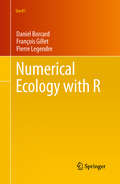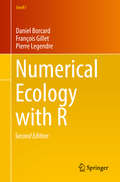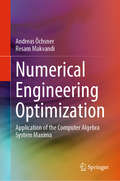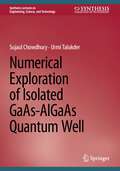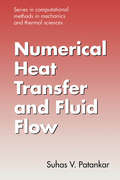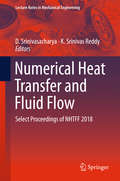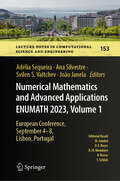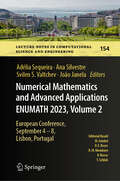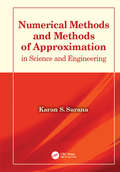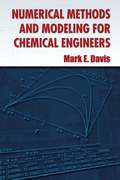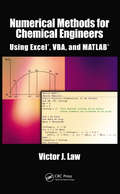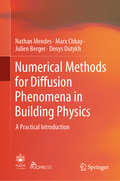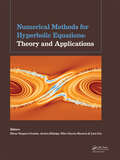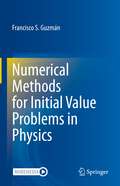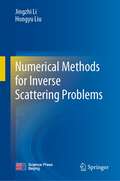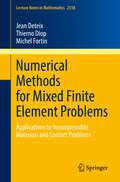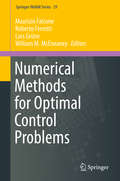- Table View
- List View
Numbers (Picture This)
by Judith NouvionNumbers are everywhere in nature. From one tiny red-eyed frog to ten sweet and scruffy dogs, children will practice counting to ten all while finding out some fun facts about animals in our natural world. Vibrant photography and simple, fun read-aloud text make this board book a perfect first look at nonfiction for very new and curious learners! The Picture This series pairs learning concepts with extraordinary photographs of animals in their habitats. Check out all four books in the Picture This series: Colors, Homes, Numbers, and Shapes!
Numbers Don't Lie: 71 Stories to Help Us Understand the Modern World
by Vaclav Smil"There is no author whose books I look forward to more than Vaclav Smil."--Bill GatesAn essential guide to understanding how numbers reveal the true state of our world--exploring a wide range of topics including energy, the environment, technology, transportation, and food production.Vaclav Smil's mission is to make facts matter. An environmental scientist, policy analyst, and a hugely prolific author, he is Bill Gates' go-to guy for making sense of our world. In Numbers Don't Lie, Smil answers questions such as: What's worse for the environment--your car or your phone? How much do the world's cows weigh (and what does it matter)? And what makes people happy? From data about our societies and populations, through measures of the fuels and foods that energize them, to the impact of transportation and inventions of our modern world--and how all of this affects the planet itself--in Numbers Don't Lie, Vaclav Smil takes us on a fact-finding adventure, using surprising statistics and illuminating graphs to challenge conventional thinking. Packed with fascinating information and memorable examples, Numbers Don't Lie reveals how the US is leading a rising worldwide trend in chicken consumption, that vaccination yields the best return on investment, and why electric cars aren't as great as we think (yet). Urgent and essential, with a mix of science, history, and wit--all in bite-sized chapters on a broad range of topics--Numbers Don't Lie inspires readers to interrogate what they take to be true.
Numbers and the Making of Us: Counting and the Course of Human Cultures
by Caleb EverettNumber concepts are a human invention developed and refined over millennia. They allow us to grasp quantities precisely: recent research shows that most specific quantities are not perceived in the absence of a number system. Numbers are not innate or universal; yet without them, the world as we know it would not exist.
Numerical Algebra, Matrix Theory, Differential-Algebraic Equations and Control Theory
by Peter Benner Matthias Bollhöfer Daniel Kressner Christian Mehl Tatjana StykelThis edited volume highlights the scientific contributions of Volker Mehrmann, a leading expert in the area of numerical (linear) algebra, matrix theory, differential-algebraic equations and control theory. These mathematical research areas are strongly related and often occur in the same real-world applications. The main areas where such applications emerge are computational engineering and sciences, but increasingly also social sciences and economics. This book also reflects some of Volker Mehrmann's major career stages. Starting out working in the areas of numerical linear algebra (his first full professorship at TU Chemnitz was in "Numerical Algebra," hence the title of the book) and matrix theory, Volker Mehrmann has made significant contributions to these areas ever since. The highlights of these are discussed in Parts I and II of the present book. Often the development of new algorithms in numerical linear algebra is motivated by problems in system and control theory. These and his later major work on differential-algebraic equations, to which he together with Peter Kunkel made many groundbreaking contributions, are the topic of the chapters in Part III. Besides providing a scientific discussion of Volker Mehrmann's work and its impact on the development of several areas of applied mathematics, the individual chapters stand on their own as reference works for selected topics in the fields of numerical (linear) algebra, matrix theory, differential-algebraic equations and control theory. "
Numerical Analysis in Electromagnetics: The TLM Method
by Pierre SaguetThe aim of this book is to give a broad overview of the TLM (Transmission Line Matrix) method, which is one of the “time-domain numerical methods”. These methods are reputed for their significant reliance on computer resources. However, they have the advantage of being highly general. The TLM method has acquired a reputation for being a powerful and effective tool by numerous teams and still benefits today from significant theoretical developments. In particular, in recent years, its ability to simulate various situations with excellent precision, including complex materials, has been demonstrated. Application examples are included in the last two chapters of the book, enabling the reader to draw conclusions regarding the performance of the implemented techniques and, at the same time, to validate them. Contents 1. Basis of the TLM Method: the 2D TLM Method. 2. 3D Nodes. 3. Introduction of Discrete Elements and Thin Wires in the TLM Method. 4. The TLM Method in Matrix Form and the Z Transform. Appendix A. Development of Maxwell’s Equations using the Z Transform with a Variable Mesh. Appendix B. Treatment of Plasma using the Z Transform for the TLM Method.
Numerical Analysis of Heat and Mass Transfer in Porous Media
by J.M.P.Q. Delgado Antonio Gilson Lima Marta Vázquez SilvaThe purpose of 'Numerical Analysis of Heat and Mass Transfer in Porous Media' is to provide a collection of recent contributions in the field of computational heat and mass transfer in porous media. The main benefit of the book is that it discusses the majority of the topics related to numerical transport phenomenon in engineering (including state-of-the-art and applications) and presents some of the most important theoretical and computational developments in porous media and transport phenomenon domain, providing a self-contained major reference that is appealing to both the scientists, researchers and the engineers. At the same time, these topics encounter of a variety of scientific and engineering disciplines, such as chemical, civil, agricultural, mechanical engineering, etc. The book is divided in several chapters that intend to be a resume of the current state of knowledge for benefit of professional colleagues.
Numerical Approximation of Exact Controls for Waves
by Enrique Zuazua Sylvain ErvedozaThis book is devoted to fully developing and comparing the two main approaches to the numerical approximation of controls for wave propagation phenomena: the continuous and the discrete. This is accomplished in the abstract functional setting of conservative semigroups.The main results of the work unify, to a large extent, these two approaches, which yield similaralgorithms and convergence rates. The discrete approach, however, gives not only efficient numerical approximations of the continuous controls, but also ensures some partial controllability properties of the finite-dimensional approximated dynamics. Moreover, it has the advantage of leading to iterative approximation processes that converge without a limiting threshold in the number of iterations. Such a threshold, which is hard to compute and estimate in practice, is a drawback of the methods emanating from the continuous approach. To complement this theory, the book provides convergence results for the discrete wave equation when discretized using finite differences and proves the convergence of the discrete wave equation with non-homogeneous Dirichlet conditions. The first book to explore these topics in depth, "On the Numerical Approximations of Controls for Waves" has rich applications to data assimilation problems and will be of interest to researchers who deal with wave approximations.
Numerical Cognition and the Epistemology of Arithmetic
by Markus PantsarArithmetic is one of the foundations of our educational systems, but what exactly is it? Numbers are everywhere in our modern societies, but what is our knowledge of numbers really about? This book provides a philosophical account of arithmetical knowledge that is based on the state-of-the-art empirical studies of numerical cognition. It explains how humans have developed arithmetic from humble origins to its modern status as an almost universally possessed knowledge and skill. Central to the account is the realisation that, while arithmetic is a human creation, the development of arithmetic is constrained by our evolutionarily developed cognitive architecture. Arithmetic is a sophisticated cultural development, but it is ultimately based on abilities with numerosities that we already possess as infants and share with many non-human animals. Therefore, arithmetic is not purely conventional, an arbitrary game akin to chess. Instead, arithmetic is deeply connected to our basic cognitive capacities.
Numerical Ecology with R
by Francois Gillet Daniel Borcard Pierre LegendreNumerical Ecology with R provides a long-awaited bridge between a textbook in Numerical Ecology and the implementation of this discipline in the R language. After short theoretical overviews, the authors accompany the users through the exploration of the methods by means of applied and extensively commented examples. Users are invited to use this book as a teaching companion at the computer. The travel starts with exploratory approaches, proceeds with the construction of association matrices, then addresses three families of methods: clustering, unconstrained and canonical ordination, and spatial analysis. All the necessary data files, the scripts used in the chapters, as well as the extra R functions and packages written by the authors, can be downloaded from a web page accessible through the Springer web site(http://adn.biol.umontreal.ca/~numericalecology/numecolR/). This book is aimed at professional researchers, practitioners, graduate students and teachers in ecology, environmental science and engineering, and in related fields such as oceanography, molecular ecology, agriculture and soil science, who already have a background in general and multivariate statistics and wish to apply this knowledge to their data using the R language, as well as people willing to accompany their disciplinary learning with practical applications. People from other fields (e.g. geology, geography, paleoecology, phylogenetics, anthropology, the social and education sciences, etc.) may also benefit from the materials presented in this book. The three authors teach numerical ecology, both theoretical and practical, to a wide array of audiences, in regular courses in their Universities and in short courses given around the world. Daniel Borcard is lecturer of Biostatistics and Ecology and researcher in Numerical Ecology at Université de Montréal, Québec, Canada. François Gillet is professor of Community Ecology and Ecological Modelling at Université de Franche-Comté, Besançon, France. Pierre Legendre is professor of Quantitative Biology and Ecology at Université de Montréal, Fellow of the Royal Society of Canada, and ISI Highly Cited Researcher in Ecology/Environment.
Numerical Ecology with R (Use R!)
by Daniel Borcard Pierre Legendre François GilletThis new edition of Numerical Ecology with R guides readers through an applied exploration of the major methods of multivariate data analysis, as seen through the eyes of three ecologists. It provides a bridge between a textbook of numerical ecology and the implementation of this discipline in the R language. The book begins by examining some exploratory approaches. It proceeds logically with the construction of the key building blocks of most methods, i.e. association measures and matrices, and then submits example data to three families of approaches: clustering, ordination and canonical ordination. The last two chapters make use of these methods to explore important and contemporary issues in ecology: the analysis of spatial structures and of community diversity. The aims of methods thus range from descriptive to explanatory and predictive and encompass a wide variety of approaches that should provide readers with an extensive toolbox that can address a wide palette of questions arising in contemporary multivariate ecological analysis. The second edition of this book features a complete revision to the R code and offers improved procedures and more diverse applications of the major methods. It also highlights important changes in the methods and expands upon topics such as multiple correspondence analysis, principal response curves and co-correspondence analysis. New features include the study of relationships between species traits and the environment, and community diversity analysis. This book is aimed at professional researchers, practitioners, graduate students and teachers in ecology, environmental science and engineering, and in related fields such as oceanography, molecular ecology, agriculture and soil science, who already have a background in general and multivariate statistics and wish to apply this knowledge to their data using the R language, as well as people willing to accompany their disciplinary learning with practical applications. People from other fields (e.g. geology, geography, paleoecology, phylogenetics, anthropology, the social and education sciences, etc.) may also benefit from the materials presented in this book. Users are invited to use this book as a teaching companion at the computer. All the necessary data files, the scripts used in the chapters, as well as extra R functions and packages written by the authors of the book, are available online (URL: http://adn.biol.umontreal.ca/~numericalecology/numecolR/).
Numerical Engineering Optimization: Application of the Computer Algebra System Maxima
by Andreas Öchsner Resam MakvandiThis study aid on numerical optimization techniques is intended for university undergraduate and postgraduate mechanical engineering students. Optimization procedures are becoming more and more important for lightweight design, where weight reduction can, for example in the case of automotive or aerospace industry, lead to lower fuel consumption and a corresponding reduction in operational costs as well as beneficial effects on the environment. Based on the free computer algebra system Maxima, the authors present procedures for numerically solving problems in engineering mathematics as well as applications taken from traditional courses on the strength of materials. The mechanical theories focus on the typical one-dimensional structural elements, i.e., springs, bars, and Euler–Bernoulli beams, in order to reduce the complexity of the numerical framework and limit the resulting design to a low number of variables. The use of a computer algebra system and the incorporated functions, e.g., for derivatives or equation solving, allows a greater focus on the methodology of the optimization methods and not on standard procedures. The book also provides numerous examples, including some that can be solved using a graphical approach to help readers gain a better understanding of the computer implementation.
Numerical Exploration of Isolated GaAs-AlGaAs Quantum Well (Synthesis Lectures on Engineering, Science, and Technology)
by Sujaul Chowdhury Urmi TalukderThis book begins with the eigenvalue equation of energy and presents calculation of the energy spectrum of GaAs-AlGaAs Quantum Well using finite difference method and knowledge of potential energy profile, without using expressions for eigenfunctions, continuity of eigenfunctions, or their spatial derivatives at the two abrupt potential steps. The authors find that the results are almost the same as those obtained by solving numerically using regula falsi method, and transcendental equations that are obeyed by the energy levels, where the transcendental equations are obtained by requiring continuity of eigenfunctions and of their spatial derivatives at the two potential steps. Thus, this book confirms that it is possible to numerically calculate the energy spectrum of Quantum Well by the finite difference method when it is not correct or when it is not possible to use continuity of eigenfunctions and their spatial derivatives at the two abrupt potential steps. The authors also showthat it is possible to use the finite difference method in cases where the potential steps are non-abrupt. The book demonstrates this by calculating the energy spectrum of isolated parabolic Quantum Well of finite depth using finite difference method.
Numerical Heat Transfer and Fluid Flow (Hemisphere Series On Computational Methods In Mechanics And Thermal Sciences)
by Suhas PatankarThis book focuses on heat and mass transfer, fluid flow, chemical reaction, and other related processes that occur in engineering equipment, the natural environment, and living organisms. Using simple algebra and elementary calculus, the author develops numerical methods for predicting these processes mainly based on physical considerations. Through this approach, readers will develop a deeper understanding of the underlying physical aspects of heat transfer and fluid flow as well as improve their ability to analyze and interpret computed results.
Numerical Heat Transfer and Fluid Flow: Select Proceedings Of NHTFF 2018 (Lecture Notes In Mechanical Engineering)
by D. Srinivasacharya K. Srinivas ReddyThis book comprises selected papers from the International Conference on Numerical Heat Transfer and Fluid Flow (NHTFF 2018), and presents the latest developments in computational methods in heat and mass transfer. It also discusses numerical methods such as finite element, finite difference, and finite volume applied to fluid flow problems. Providing a good balance between computational methods and analytical results applied to a wide variety of problems in heat transfer, transport and fluid mechanics, the book is a valuable resource for students and researchers working in the field of heat transfer and fluid dynamics.
Numerical Mathematics and Advanced Applications ENUMATH 2023, Volume 1: European Conference, September 4-8, Lisbon, Portugal (Lecture Notes in Computational Science and Engineering #153)
by Adélia Sequeira Ana Silvestre Svilen S. Valtchev João JanelaThis book gathers outstanding papers presented at the European Conference on Numerical Mathematics and Advanced Applications, ENUMATH 2023. The conference was held in Lisbon, Portugal, in September 2023. Leading experts in the field presented the latest results and ideas regarding the design, implementation and analysis of numerical algorithms, as well as their applications to relevant societal problems. ENUMATH is a series of conferences held every two years to provide a forum for discussing basic aspects and new trends in numerical mathematics and its scientific and industrial applications, all examined at the highest level of international expertise. The first ENUMATH was held in Paris in 1995, with successive installments at various sites across Europe, including Heidelberg (1997), Jyvaskyla (1999), lschia Porto (2001), Prague (2003), Santiago de Compostela (2005), Graz (2007), Uppsala (2009), Leicester (2011), Lausanne (2013), Ankara (2015), Bergen (2017), and Egmond aan Zee (2019).
Numerical Mathematics and Advanced Applications ENUMATH 2023, Volume 2: European Conference, September 4-8, Lisbon, Portugal (Lecture Notes in Computational Science and Engineering #154)
by Adélia Sequeira Ana Silvestre Svilen S. Valtchev João JanelaThis book gathers outstanding papers presented at the European Conference on Numerical Mathematics and Advanced Applications, ENUMATH 2023. The conference was held in Lisbon, Portugal, in September 2023. Leading experts in the field presented the latest results and ideas regarding the design, implementation and analysis of numerical algorithms, as well as their applications to relevant societal problems. ENUMATH is a series of conferences held every two years to provide a forum for discussing basic aspects and new trends in numerical mathematics and its scientific and industrial applications, all examined at the highest level of international expertise. The first ENUMATH was held in Paris in 1995, with successive installments at various sites across Europe, including Heidelberg (1997), Jyvaskyla (1999), lschia Porto (2001), Prague (2003), Santiago de Compostela (2005), Graz (2007), Uppsala (2009), Leicester (2011), Lausanne (2013), Ankara (2015), Bergen (2017), and Egmond aan Zee (2019).
Numerical Methods and Methods of Approximation in Science and Engineering
by Karan S. SuranaNumerical Methods and Methods of Approximation in Science and Engineering prepares students and other readers for advanced studies involving applied numerical and computational analysis. Focused on building a sound theoretical foundation, it uses a clear and simple approach backed by numerous worked examples to facilitate understanding of numerical methods and their application. Readers will learn to structure a sequence of operations into a program, using the programming language of their choice; this approach leads to a deeper understanding of the methods and their limitations. The text features highlighted examples, numerous problems, and a complete Solutions Manual for instructors.
Numerical Methods and Modeling for Chemical Engineers
by Mark E. DavisThis text introduces computational tools for solving differential equation models that arise in chemical engineering: diffusion-reactions, mass-heat transfer, and fluid flow. Geared toward advanced undergraduates or graduate students of chemical engineering studying applied mathematics, the treatment focuses on numerical methods and modeling implemented in commercial mathematical software available at the time of its initial publication in 1984. The introductory-level approach outlines numerical techniques for differential equations that either illustrate a computation property of interest or form the underlying methods of a computer software package. Readers are assumed to have a basic knowledge of mathematics, and results requiring further background feature appropriate references. Each chapter includes illustrative examples, and problems at the chapter's end simulate industrial mathematics projects and form extensions of the examples. Helpful appendixes supplement the text.
Numerical Methods for Chemical Engineers Using Excel, VBA, and MATLAB
by Victor J. LawWhile teaching the Numerical Methods for Engineers course over the last 15 years, the author found a need for a new textbook, one that was less elementary, provided applications and problems better suited for chemical engineers, and contained instruction in Visual Basic for Applications (VBA). This led to six years of developing teaching notes that
Numerical Methods for Diffusion Phenomena in Building Physics: A Practical Introduction
by Nathan Mendes Marx Chhay Julien Berger Denys DutykhThis book is the second edition of Numerical methods for diffusion phenomena in building physics: a practical introduction originally published by PUCPRESS (2016). It intends to stimulate research in simulation of diffusion problems in building physics, by providing an overview of mathematical models and numerical techniques such as the finite difference and finite-element methods traditionally used in building simulation tools. Nonconventional methods such as reduced order models, boundary integral approaches and spectral methods are presented, which might be considered in the next generation of building-energy-simulation tools. In this reviewed edition, an innovative way to simulate energy and hydrothermal performance are presented, bringing some light on innovative approaches in the field.
Numerical Methods for Hyperbolic Equations
by Pilar García-Navarro Elena Vázquez-Cendón Arturo Hidalgo Luis CeaNumerical Methods for Hyperbolic Equations is a collection of 49 articles presented at the International Conference on Numerical Methods for Hyperbolic Equations: Theory and Applications (Santiago de Compostela, Spain, 4-8 July 2011). The conference was organized to honour Professor Eleuterio Toro in the month of his 65th birthday. The topics cover
Numerical Methods for Initial Value Problems in Physics
by Francisco S. GuzmánThis textbook is a comprehensive overview of the construction, implementation, and application of important numerical methods for the solution of Initial Value Problems (IVPs). Beginning with IVPs involving Ordinary Differential Equations (ODEs) and progressing to problems with Partial Differential Equations (PDEs) in 1+1 and 3+1 dimensions, it provides readers with a clear and systematic progression from simple to complex concepts. The numerical methods selected in this textbook can solve a considerable variety of problems and the applications presented cover a wide range of topics, including population dynamics, chaos, celestial mechanics, geophysics, astrophysics, and more. Each chapter contains a variety of solved problems and exercises, with code included. These examples are designed to motivate and inspire readers to delve deeper into the state-of-the-art problems in their own fields. The code is written in Fortran 90, in a library-free style, making them easy to program and efficient to run. The appendix also includes the same code in C++, making the book accessible to a variety of programming backgrounds. At the end of each chapter, there are brief descriptions of how the methods could be improved, along with one or two projects that can be developed with the methods and codes described. These projects are highly engaging, from synchronization of chaos and message encryption to gravitational waves emitted by a binary system and non-linear absorption of a scalar field. With its clear explanations, hands-on approach, and practical examples, this textbook is an essential resource for advanced undergraduate and graduate students who want to the learn how to use numerical methods to tackle challenging problems.
Numerical Methods for Inverse Scattering Problems
by Jingzhi Li Hongyu LiuThis book highlights the latest developments on the numerical methods for inverse scattering problems associated with acoustic, electromagnetic, and elastic waves. Inverse scattering problems are concerned with identifying unknown or inaccessible objects by wave probing data, which makes possible many industrial and engineering applications including radar and sonar, medical imaging, nondestructive testing, remote sensing, and geophysical exploration. The mathematical study of inverse scattering problems is an active field of research. This book presents a comprehensive and unified mathematical treatment of various inverse scattering problems mainly from a numerical reconstruction perspective. It highlights the collaborative research outputs by the two groups of the authors yet surveys and reviews many existing results by global researchers in the literature. The book consists of three parts respectively corresponding to the studies on acoustic, electromagnetic, and elastic scattering problems. In each part, the authors start with in-depth theoretical and computational treatments of the forward scattering problems and then discuss various numerical reconstruction schemes for the associated inverse scattering problems in different scenarios of practical interest. In addition, the authors provide an overview of the existing results in the literature by other researchers. This book can serve as a handy reference for researchers or practitioners who are working on or implementing inverse scattering methods. It can also serve as a graduate textbook for research students who are interested in working on numerical algorithms for inverse scattering problems.
Numerical Methods for Mixed Finite Element Problems: Applications to Incompressible Materials and Contact Problems (Lecture Notes in Mathematics #2318)
by Michel Fortin Jean Deteix Thierno DiopThis book focuses on iterative solvers and preconditioners for mixed finite element methods. It provides an overview of some of the state-of-the-art solvers for discrete systems with constraints such as those which arise from mixed formulations.Starting by recalling the basic theory of mixed finite element methods, the book goes on to discuss the augmented Lagrangian method and gives a summary of the standard iterative methods, describing their usage for mixed methods. Here, preconditioners are built from an approximate factorisation of the mixed system.A first set of applications is considered for incompressible elasticity problems and flow problems, including non-linear models.An account of the mixed formulation for Dirichlet’s boundary conditions is then given before turning to contact problems, where contact between incompressible bodies leads to problems with two constraints.This book is aimed at graduate students and researchers in the field of numerical methods and scientific computing.
Numerical Methods for Optimal Control Problems (Springer INdAM Series #29)
by Lars Grüne Maurizio Falcone Roberto Ferretti William M. McEneaneyThis work presents recent mathematical methods in the area of optimal control with a particular emphasis on the computational aspects and applications. Optimal control theory concerns the determination of control strategies for complex dynamical systems, in order to optimize some measure of their performance. Started in the 60's under the pressure of the "space race" between the US and the former USSR, the field now has a far wider scope, and embraces a variety of areas ranging from process control to traffic flow optimization, renewable resources exploitation and management of financial markets. These emerging applications require more and more efficient numerical methods for their solution, a very difficult task due the huge number of variables. The chapters of this volume give an up-to-date presentation of several recent methods in this area including fast dynamic programming algorithms, model predictive control and max-plus techniques. This book is addressed to researchers, graduate students and applied scientists working in the area of control problems, differential games and their applications.
